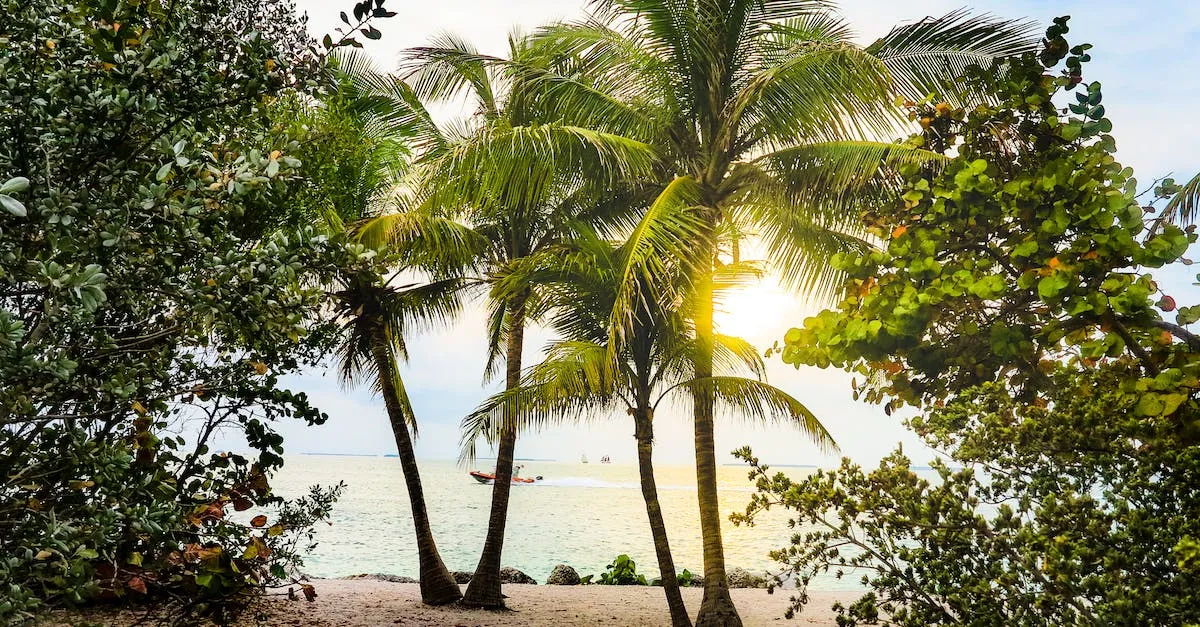How Many Palm Trees Are In Florida? An In-Depth Look
With its subtropical climate and extensive coastline, Florida is world-renowned for its palm trees. Their iconic fronds and tropical vibe have become a symbol of the Sunshine State. But just how many palm trees exist across Florida’s diverse landscapes? This article will examine the numerous species, estimated totals, regional densities, and threats impacting these distinctive trees.
If you’re pressed for time, here’s a quick answer: Florida is estimated to have over 15 million palm trees across public and private lands.
Palm Tree Species Common in Florida
Florida is known for its beautiful palm trees that line its sandy beaches and decorate its landscapes. With its tropical climate, Florida provides the perfect environment for various palm tree species to thrive. Here are some of the most common palm tree species found in the state:
Coconut Palm
The Coconut Palm, also known as Cocos nucifera, is perhaps one of the most iconic palm tree species in Florida. With its tall slender trunk and large fronds, it instantly evokes images of a tropical paradise. Coconut Palms are not only aesthetically pleasing but also have practical uses.
The coconuts they produce are enjoyed by both locals and tourists alike.
Date Palm
The Date Palm, scientifically known as Phoenix dactylifera, is another popular palm tree species in Florida. These trees are characterized by their large, feathery fronds and tall trunks. Date Palms are not only admired for their beauty but also for the delicious fruit they bear.
Dates have been consumed for centuries and are known for their sweet taste and nutritional value.
Pindo Palm
The Pindo Palm, or Butia capitata, is a smaller palm tree species commonly found in Florida. It is known for its unique blue-gray color and its ability to withstand colder temperatures compared to other palm tree varieties.
Pindo Palms are often used in landscaping due to their attractive appearance and low maintenance requirements.
Queen Palm
The Queen Palm, scientifically named Syagrus romanzoffiana, is a graceful and elegant palm tree species frequently seen in Florida. Its long, arching fronds and smooth gray trunk make it a favorite among landscapers and homeowners.
Queen Palms are often used as ornamental trees due to their ability to add a touch of sophistication to any outdoor space.
Sabal Palm
The Sabal Palm, also known as Sabal palmetto, is the state tree of Florida. This palm tree species is native to the southeastern United States and can be found in abundance throughout the state. Its fan-shaped fronds and sturdy trunk make it a recognizable and beloved symbol of Florida’s natural beauty.
These are just a few examples of the palm tree species commonly found in Florida. Each species offers its own unique characteristics and contributes to the diverse and vibrant palm tree population in the state.
Estimates of Total Numbers Statewide
When it comes to palm trees, Florida is known for its vast numbers. With its warm climate and tropical landscapes, it’s no wonder that palm trees thrive in the state. But just how many palm trees are there in Florida?
While it’s difficult to determine an exact number, there have been several estimates made by experts in the field.
Florida’s Diverse Palm Tree Species
Florida is home to a wide variety of palm tree species, each with its own unique characteristics and appearance. Some of the most common species found in the state include the Sabal Palm, Coconut Palm, and Date Palm.
These palm trees can be found in abundance across the state, from the sandy beaches of Miami to the swamps of the Everglades.
Estimating the Total Number
Estimating the total number of palm trees in Florida is a challenging task. One method used by experts is aerial surveys, where helicopters or drones are used to count the number of palm trees in a given area.
These surveys provide valuable data, but they are time-consuming and expensive to conduct on a statewide scale.
Another approach is to use statistical models based on sample data. Scientists collect data from specific areas and extrapolate that information to estimate the total number of palm trees in the state.
While this method is more cost-effective, it may not be as accurate as conducting a comprehensive aerial survey.
Varied Results and Uncertainty
Due to the challenges involved in accurately counting palm trees, estimates of the total number in Florida can vary. According to a study conducted by the University of Florida, the state is estimated to have over 40 million palm trees.
However, other estimates suggest that the number could be higher or lower, depending on the methodology used.
It’s important to remember that these estimates are not definitive and should be taken with a grain of salt. Palm trees are constantly growing and changing, and new ones are planted regularly. Additionally, factors such as hurricanes, disease, and urban development can impact the overall number of palm trees in the state.
Palm Tree Concentrations by Region
Southeast Coast
The Southeast Coast of Florida is known for its lush tropical landscapes and stunning beaches, and it is no surprise that this region is home to a high concentration of palm trees. From Miami to Palm Beach, you will find an abundance of different palm tree species lining the streets, parks, and private properties.
Some popular palm tree varieties found in this region include the Royal Palm (Roystonea regia), Coconut Palm (Cocos nucifera), and the Foxtail Palm (Wodyetia bifurcata).
If you take a stroll along Ocean Drive in Miami Beach, you’ll be greeted by a breathtaking sight of palm trees swaying in the ocean breeze. The iconic palm-lined streets of Palm Beach create a picturesque backdrop for residents and visitors alike.
The Southeast Coast’s warm and humid climate provides the perfect conditions for palm trees to thrive, contributing to its high concentration in this region.
Central Florida
While the Southeast Coast may be the most well-known for its palm tree concentrations, Central Florida also boasts a significant number of palms. Orlando, the heart of Central Florida, is home to numerous palm tree species, including the popular Canary Island Date Palm (Phoenix canariensis) and the Sabal Palm (Sabal palmetto).
Central Florida’s subtropical climate and fertile soil make it an ideal environment for palm trees to grow. Many residential neighborhoods, theme parks, and botanical gardens in the region showcase the beauty of these majestic trees.
Whether you’re walking through the streets of downtown Orlando or exploring the landscapes of Walt Disney World, you’ll encounter an impressive display of palm trees.
Florida Keys
The Florida Keys, a string of tropical islands stretching off the southern tip of Florida, is renowned for its stunning natural beauty. Palm trees play a significant role in creating the picturesque landscapes that make the Keys so unique.
The region is home to various palm tree species, including the Key Thatch Palm (Leucothrinax morrisii) and the Coconut Palm.
Driving along the Overseas Highway, which connects the islands of the Florida Keys, you’ll witness a breathtaking sight of palm trees swaying against the backdrop of crystal-clear turquoise waters. From Key Largo to Key West, palm trees are an integral part of the region’s identity, adding to its tropical allure.
For more information on palm trees in Florida and their various species, you can visit the Florida Museum Herbarium website. This website provides a comprehensive database of plant specimens, including palm trees, found in Florida, making it a valuable resource for botanists and nature enthusiasts.
Threats to Palm Trees in Florida
Florida is known for its beautiful palm trees that line its beaches and landscapes. However, these iconic trees face several threats that endanger their existence. Understanding these threats is crucial in preserving the natural beauty and ecological balance of the state.
Hurricanes
Hurricanes are a major threat to palm trees in Florida. The state is prone to hurricanes due to its geographical location. These powerful storms can cause significant damage to palm trees, uprooting them or breaking their trunks.
In extreme cases, entire groves of palm trees can be decimated by the strong winds and storm surges associated with hurricanes. Efforts are being made to plant more hurricane-resistant varieties of palm trees in vulnerable areas to mitigate the impact of these natural disasters.
Invasive Pests
Invasive pests pose a significant threat to palm trees in Florida. One such pest is the red palm weevil. Originally from Southeast Asia, this destructive insect has made its way to Florida and poses a serious threat to the state’s palm tree population.
The red palm weevil attacks the heart of the palm tree, leading to its ultimate demise. Other invasive pests, such as the coconut rhinoceros beetle and the palm leaf skeletonizer, also pose a threat to palm trees.
Efforts are underway to control and eradicate these invasive pests to protect the palm tree population.
Diseases
Diseases can also have a devastating impact on palm trees in Florida. One of the most notable diseases is lethal bronzing, also known as Texas Phoenix palm decline. This bacterial disease affects various palm species and causes wilting, discoloration, and eventual death of the tree.
Another disease called fusarium wilt affects some species of palm trees, causing yellowing and wilting of the leaves. Identifying and treating these diseases early is crucial in preventing the spread and saving infected palm trees.
Research and monitoring programs are in place to detect and control the spread of these diseases.
Ongoing Palm Tree Conservation
Conservation efforts play a crucial role in maintaining the rich biodiversity of palm trees in Florida. These majestic trees not only add to the beauty of the state’s landscape but also provide numerous benefits to the environment.
To ensure the preservation of these iconic trees, various strategies are being implemented, including the use of resistant cultivars, responsible planting practices, and swift disease response.
Resistant Cultivars
One way to protect palm trees from diseases and pests is by cultivating resistant varieties. Plant breeders and horticulturists have been working tirelessly to develop palm tree cultivars that are more resilient and less susceptible to common diseases.
These resistant cultivars not only help maintain the overall health of the palm tree population but also reduce the need for excessive pesticide use. Some examples of resistant palm tree cultivars include the ‘Sabal palmetto’ and the ‘Phoenix roebelenii.’
Responsible Planting
Responsible planting practices are essential for the long-term survival of palm trees in Florida. This involves selecting appropriate planting locations, ensuring proper soil conditions, and providing adequate care and maintenance.
Planting palm trees in areas where they can thrive without causing harm to nearby ecosystems is crucial. Additionally, proper irrigation and regular pruning can help prevent the spread of diseases and maintain the overall health of the trees.
Swift Disease Response
Timely detection and swift response to diseases affecting palm trees are critical in preventing the spread of infections. The Florida Department of Agriculture and Consumer Services, along with other organizations, actively monitor and control the occurrence of diseases such as lethal bronzing and Fusarium wilt.
By promptly identifying infected trees, implementing appropriate treatment measures, and educating the public on disease prevention, authorities can effectively mitigate the impact of these diseases on the palm tree population.
For more information on ongoing palm tree conservation efforts in Florida, you can visit the official website of the Florida Department of Agriculture and Consumer Services.
Conclusion
Florida’s millions of graceful palm trees are an iconic part of its landscape. But continued conservation efforts are crucial to preserve these important native and introduced species.
Estimating total numbers statewide helps underscore their significance and the need for sustainable practices. Hopefully this overview provided helpful context on just how abundant palm trees are across Florida.








